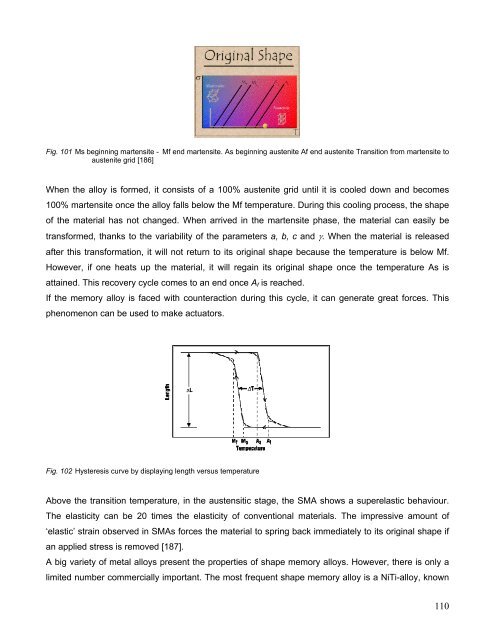Clevertex - Grado Zero Espace Srl
Clevertex - Grado Zero Espace Srl
Clevertex - Grado Zero Espace Srl
You also want an ePaper? Increase the reach of your titles
YUMPU automatically turns print PDFs into web optimized ePapers that Google loves.
Fig. 101 Ms beginning martensite - Mf end martensite. As beginning austenite Af end austenite Transition from martensite to<br />
austenite grid [186]<br />
When the alloy is formed, it consists of a 100% austenite grid until it is cooled down and becomes<br />
100% martensite once the alloy falls below the Mf temperature. During this cooling process, the shape<br />
of the material has not changed. When arrived in the martensite phase, the material can easily be<br />
transformed, thanks to the variability of the parameters a, b, c and γ. When the material is released<br />
after this transformation, it will not return to its original shape because the temperature is below Mf.<br />
However, if one heats up the material, it will regain its original shape once the temperature As is<br />
attained. This recovery cycle comes to an end once Af is reached.<br />
If the memory alloy is faced with counteraction during this cycle, it can generate great forces. This<br />
phenomenon can be used to make actuators.<br />
Fig. 102 Hysteresis curve by displaying length versus temperature<br />
Above the transition temperature, in the austensitic stage, the SMA shows a superelastic behaviour.<br />
The elasticity can be 20 times the elasticity of conventional materials. The impressive amount of<br />
‘elastic’ strain observed in SMAs forces the material to spring back immediately to its original shape if<br />
an applied stress is removed [187].<br />
A big variety of metal alloys present the properties of shape memory alloys. However, there is only a<br />
limited number commercially important. The most frequent shape memory alloy is a NiTi-alloy, known<br />
110

















